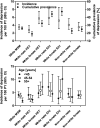Frequency of and Risk Factors for Depression among Participants in the Swiss HIV Cohort Study (SHCS)
- PMID: 26492488
- PMCID: PMC4619594
- DOI: 10.1371/journal.pone.0140943
Frequency of and Risk Factors for Depression among Participants in the Swiss HIV Cohort Study (SHCS)
Abstract
Objectives: We studied the incidence and prevalence of, and co-factors for depression in the Swiss HIV Cohort Study.
Methods: Depression-specific items were introduced in 2010 and prospectively collected at semiannual cohort visits. Clinical, laboratory and behavioral co-factors of incident depression among participants free of depression at the first two visits in 2010 or thereafter were analyzed with Poisson regression. Cumulative prevalence of depression at the last visit was analyzed with logistic regression.
Results: Among 4,422 participants without a history of psychiatric disorders or depression at baseline, 360 developed depression during 9,348 person-years (PY) of follow-up, resulting in an incidence rate of 3.9 per 100 PY (95% confidence interval (CI) 3.5-4.3). Cumulative prevalence of depression during follow-up was recorded for 1,937/6,756 (28.7%) participants. Incidence and cumulative prevalence were higher in injection drug users (IDU) and women. Older age, preserved work ability and higher physical activity were associated with less depression episodes. Mortality (0.96 per 100 PY, 95% CI 0.83-1.11) based upon 193 deaths over 20,102 PY was higher among male IDU (2.34, 1.78-3.09), female IDU (2.33, 1.59-3.39) and white heterosexual men (1.32, 0.94-1.84) compared to white heterosexual women and homosexual men (0.53, 0.29-0.95; and 0.71, 0.55-0.92). Compared to participants free of depression, mortality was slightly elevated among participants with a history of depression (1.17, 0.94-1.45 vs. 0.86, 0.71-1.03, P = 0.033). Suicides (n = 18) did not differ between HIV transmission groups (P = 0.50), but were more frequent among participants with a prior diagnosis of depression (0.18 per 100 PY, 95%CI 0.10-0.31; vs. 0.04, 0.02-0.10; P = 0.003).
Conclusions: Depression is a frequent co-morbidity among HIV-infected persons, and thus an important focus of care.
Conflict of interest statement
Figures


Similar articles
-
Hepatitis C virus infections in the Swiss HIV Cohort Study: a rapidly evolving epidemic.Clin Infect Dis. 2012 Nov 15;55(10):1408-16. doi: 10.1093/cid/cis694. Epub 2012 Aug 14. Clin Infect Dis. 2012. PMID: 22893583
-
Prevalence of hepatitis C in an ethnically diverse HIV-1-infected cohort in south London.HIV Med. 2005 May;6(3):206-15. doi: 10.1111/j.1468-1293.2005.00291.x. HIV Med. 2005. PMID: 15876288
-
The Swiss HIV Cohort Study: rationale, organization and selected baseline characteristics.Soz Praventivmed. 1994;39(6):387-94. doi: 10.1007/BF01299670. Soz Praventivmed. 1994. PMID: 7817627 Clinical Trial.
-
Incidence and risk factors for chronic elevation of alanine aminotransferase levels in HIV-infected persons without hepatitis b or c virus co-infection.Clin Infect Dis. 2010 Feb 15;50(4):502-11. doi: 10.1086/649922. Clin Infect Dis. 2010. PMID: 20085465
-
Influence of noninjecting and injecting drug use on mortality, retention in the cohort, and antiretroviral therapy, in participants in the Swiss HIV Cohort Study.HIV Med. 2015 Mar;16(3):137-51. doi: 10.1111/hiv.12184. Epub 2014 Aug 15. HIV Med. 2015. PMID: 25124393
Cited by
-
Low Neuroactive Steroids Identifies a Biological Subtype of Depression in Adults with Human Immunodeficiency Virus on Suppressive Antiretroviral Therapy.J Infect Dis. 2021 May 20;223(9):1601-1611. doi: 10.1093/infdis/jiaa104. J Infect Dis. 2021. PMID: 32157292 Free PMC article.
-
Depression, antiretroviral therapy initiation, and HIV viral suppression among people who inject drugs in Vietnam.J Affect Disord. 2021 Feb 15;281:208-215. doi: 10.1016/j.jad.2020.12.024. Epub 2020 Dec 9. J Affect Disord. 2021. PMID: 33333474 Free PMC article.
-
Emotional Availability, Neuropsychological Functioning, and Psychopathology: The Context of Parental Substance Use Disorder.Biomed Res Int. 2018 May 17;2018:5359037. doi: 10.1155/2018/5359037. eCollection 2018. Biomed Res Int. 2018. PMID: 29888268 Free PMC article.
-
Race-Dependent Association of Single-Nucleotide Polymorphisms in TrkB Receptor in People Living with HIV and Depression.Neurotox Res. 2021 Dec;39(6):1721-1731. doi: 10.1007/s12640-021-00406-1. Epub 2021 Oct 6. Neurotox Res. 2021. PMID: 34613587 Free PMC article.
-
Longitudinal Modeling of Depressive Trajectories Among HIV-Infected Men Using Cocaine.AIDS Behav. 2017 Jul;21(7):1985-1995. doi: 10.1007/s10461-017-1801-y. AIDS Behav. 2017. PMID: 28550378 Free PMC article.
References
-
- Dew MA, Becker JT, Sanchez J, Caldararo R, Lopez OL, Wess J, et al. Prevalence and predictors of depressive, anxiety and substance use disorders in HIV-infected and uninfected men: a longitudinal evaluation. Psychological medicine. 1997;27(2):395–409. - PubMed
-
- Bing EG, Burnam MA, Longshore D, Fleishman JA, Sherbourne CD, London AS, et al. Psychiatric disorders and drug use among human immunodeficiency virus-infected adults in the United States. Archives of general psychiatry. 2001;58(8):721–8. - PubMed
-
- Ciesla JA, Roberts JE. Meta-analysis of the relationship between HIV infection and risk for depressive disorders. Am J Psychiat. 2001;158(5):725–30. - PubMed
-
- Wells KB, Stewart A, Hays RD, Burnam MA, Rogers W, Daniels M, et al. The functioning and well-being of depressed patients. Results from the Medical Outcomes Study. JAMA. 1989;262(7):914–9. - PubMed
Publication types
MeSH terms
LinkOut - more resources
Full Text Sources
Other Literature Sources
Medical

